
Learn how Jane Frenke uses fabric, a sewing machine, and her creativity to create works of art.
- Subject:
- Arts and Humanities
- Visual Arts
- Material Type:
- Activity/Lab
- Provider:
- PBS LearningMedia
- Author:
- PBS Learning Media
- Date Added:
- 06/14/2024

Learn how Jane Frenke uses fabric, a sewing machine, and her creativity to create works of art.

An interactive applet and associated web page that demonstrate the definition of a line. The applet presents two points and a line that passes through them extending to infinity in both directions. As the points a re dragged the line moves but it is never possible to reveal a line end. See also the entries for line segment and ray. Applet can be enlarged to full screen size for use with a classroom projector. This resource is a component of the Math Open Reference Interactive Geometry textbook project at http://www.mathopenref.com.
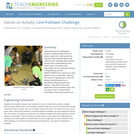
Student groups are challenged to program robots with light sensors to follow a black line. Learning both the logic and skills behind programming robots for this challenge helps students improve their understanding of how robots "think" and widens their appreciation for the complexity involved in programming LEGO® MINDSTORMS® NXT robots to do what appears to be a simple task. They test their ideas for approaches to solve the problem and ultimately learn a (provided) working programming solution. They think of real-world applications for line-follower robots that use sensor input. A PowerPoint® presentation and pre/post quizzes are provided.
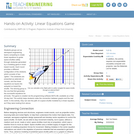
Students groups act as aerospace engineering teams competing to create linear equations to guide space shuttles safely through obstacles generated by a modeling game in level-based rounds. Each round provides a different configuration of the obstacle, which consists of two "gates." The obstacles are presented as asteroids or comets, and the linear equations as inputs into autopilot on board the shuttle. The winning group is the one that first generates the successful equations for all levels. The game is created via the programming software MATLAB, available as a free 30-day trial. The activity helps students make the connection between graphs and the real world. In this activity, they can see the path of a space shuttle modeled by a linear equation, as if they were looking from above.
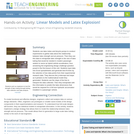
Students use latex tubes and bicycle pumps to conduct experiments to gather data about the relationship between latex strength and air pressure. Then they use this data to extrapolate latex strength to the size of latex tubing that would be needed in modern passenger sedans to serve as hybrid vehicle accelerators, thus answering the engineering design challenge question posed in the first lesson of this unit. Students input data into Excel spreadsheets and generate best fit lines by the selection of two data points from their experimental research data. They discuss the y-intercept and slope as it pertains to the mathematical model they generated. Students use the slope of the line to interpret the data collected. Then they extrapolate with this information to predict the latex dimensions that would be required for a full-size hydraulic accumulator installed in a passenger vehicle.
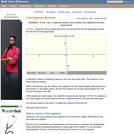
An interactive applet and associated web page that demonstrate a bisector of a line segment. The applet shows a fixed line segment and another line that bisects it. The second line's endpoints can be dragged, but the line adjusts itself so that it always bisects the fixed line. Applet can be enlarged to full screen size for use with a classroom projector. This resource is a component of the Math Open Reference Interactive Geometry textbook project at http://www.mathopenref.com.

About the Arts, Care & Connection Lesson Collection: Arts for Learning Northwest collaborated with Oregon teaching artists on this collection of arts integration modules designed for K-5 students, with integrated social emotional learning content in the areas of dance, visual arts, theater, and music.
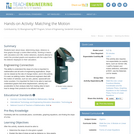
Students learn about slope, determining slope, distance vs. time graphs through a motion-filled activity. Working in teams with calculators and CBL motion detectors, students attempt to match the provided graphs and equations with the output from the detector displayed on their calculators.

About the Arts, Care & Connection Lesson Collection: Arts for Learning Northwest collaborated with Oregon teaching artists on this collection of arts integration modules designed for K-5 students, with integrated social emotional learning content in the areas of dance, visual arts, theater, and music.

Do you like to paint? Watch this step by step video as artist Kristin Farr demonstrates how to paint your very own "Magic Hecksagon," which is a colorful, geometric design inspired by folk art. She uses a plethora of different colors to bring a sense of motion to her work. Watch and learn more in the interview with Kristin Farr: http://youtu.be/OX1r-3-VK-0

About the Arts, Care & Connection Lesson Collection: Arts for Learning Northwest collaborated with Oregon teaching artists on this collection of arts integration modules designed for K-5 students, with integrated social emotional learning content in the areas of dance, visual arts, theater, and music.
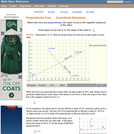
An interactive applet and associated web page that show how to determine of one line is perpendicular to another in coordinate geometry. The principle used is that if two lines a re perpendicular to each other the slope of one is the negative reciprocal of the other. The applet shows to lines that the user can move. The slopes are continuously calculated as you drag them, and if the they are parallel they change color. The calculation is shown on screen updated continuously as you drag. The grid, axis pointers and coordinates can be turned on and off. The calculation display can be turned off to permit class exercises and then turned back on the verify the answers. The applet can be printed as it appears on the screen to make handouts. The web page has a full description of the concept of perpendicularity, a worked example and has links to other pages relating to coordinate geometry. Applet can be enlarged to full screen size for use with a classroom projector. This resource is a component of the Math Open Reference Interactive Geometry textbook project at http://www.mathopenref.com.
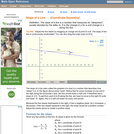
An interactive applet and associated web page that demonstrate the slope (m) of a line. The applet has two points that define a line. As the user drags either point it continuously recalculates the slope. The rise and run are drawn to show the two elements used in the calculation. The grid, axis pointers and coordinates can be turned on and off. The slope calculation can be turned off to permit class exercises and then turned back on the verify the answers. The applet can be printed as it appears on the screen to make handouts. The web page has a full description of the concept of slope, a worked example and has links to other pages relating to coordinate geometry. Applet can be enlarged to full screen size for use with a classroom projector. This resource is a component of the Math Open Reference Interactive Geometry textbook project at http://www.mathopenref.com.

Meet Bay Area artist Mike Shine, who discusses his carnival-inspired paintings, and his recent large-scale stencil murals. He makes art for people to enjoy, both superficially and in depth, and condemns much of modern art because of the context needed for interpretation. He wants his art to be able to be interpreted, regardless of how it is interpreted. He wants it to transcend cultural and language barriers. Check out how his art is made in this video.

Students learn the value of writing and art in science and engineering. They acquire vocabulary that is appropriate for explaining visual art and learn about visual design principles (contrast, alignment, repetition and proximity) and elements (lines, color, texture, shape, size, value and space) that are helpful when making visual aids. A PowerPoint(TM) presentation heightens students' awareness of the connection between art and engineering in order to improve the presentation of results, findings, concepts, information and prototype designs. Students also learn about the science and engineering research funding process that relies on effective proposal presentations, as well as some thermal conductivity / heat flow basics including the real-world example of a heat sink which prepares them for the associated activity in which they focus on creating diagrams to communicate their own collected experimental data.
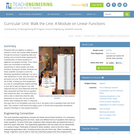
Prepared with pre-algebra or algebra 1 classes in mind, this module leads students through the process of graphing data and finding a line of best fit while exploring the characteristics of linear equations in algebraic and graphic formats. Then, these topics are connected to real-world experiences in which people use linear functions. During the module, students use these scientific concepts to solve the following hypothetical challenge: You are a new researcher in a lab, and your boss has just given you your first task to analyze a set of data. It being your first assignment, you ask an undergraduate student working in your lab to help you figure it out. She responds that you must determine what the data represents and then find an equation that models the data. You believe that you will be able to determine what the data represents on your own, but you ask for further help modeling the data. In response, she says she is not completely sure how to do it, but gives a list of equations that may fit the data. This module is built around the legacy cycle, a format that incorporates educational research feindings on how people best learn.
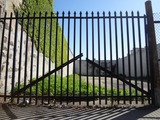
ज्ञान : १.विद्यार्थी रेषाखंडाचे विभाजन ही संकल्पना आठवतो.२.विद्यार्थी रेषाखंडाच्या विभाजनाची कृती आठवतो.३.विद्यार्थी भौमितिक साधनांची नावे आठवतो.आकलन :१.विद्यार्थी रेषाखंडाचे विभाजन ही संकल्पना स्पष्ट करतो.२.विद्यार्थी रेषाखंडाच्या विभाजनाची कृती स्पष्ट करतो.उपयोजन : १. विद्यार्थी दोन समांतर रेषांमध्ये भाग करण्यासाठी रेषाखंड दुभागण्याच्या गुणधर्माचा वापर करतो.कौशल्य :१.विद्यार्थी योग्य पद्धतीने रेषाखंडाची विभागनी करतो.२. विद्यार्थी भौमितिक साधने अचूकरीत्या हाताळतो.